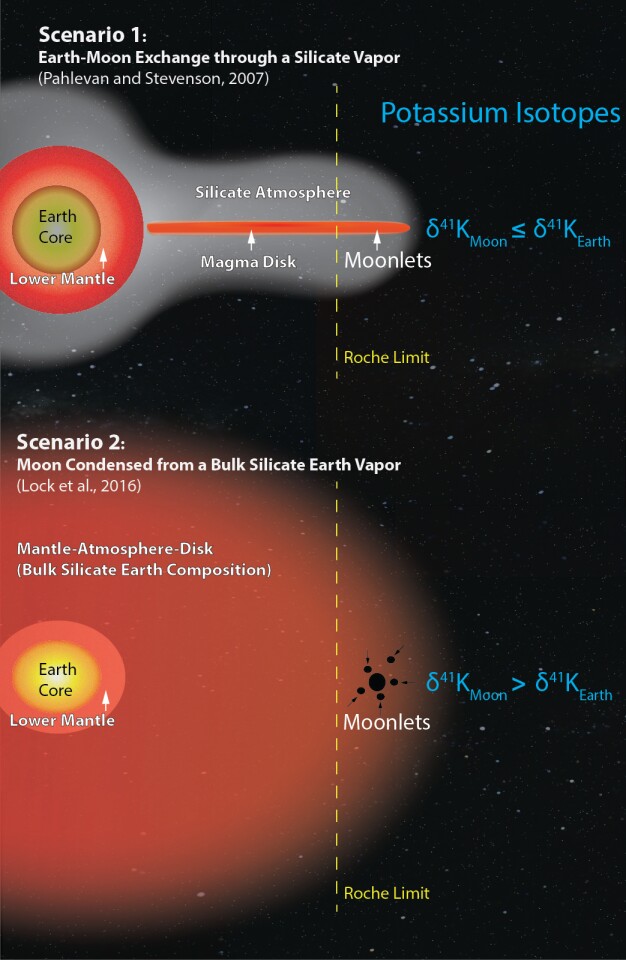A new study that analyzed isotopic differences in potassium contained in terrestrial and lunar rock samples is helping to shed light on the formation process that led to the creation of Earth's Moon. The research could help reveal the nature of a cataclysmic collision between Earth and a Mars-sized body, which is believed to have taken place in the distant past.
Elements in rocks that originated indifferent parts of the solar system are known to boast distinctive – albeit minute – differences in the compositions of their isotopes. By observingthis sort of isotopic fingerprint, scientistsare capable of determining where a sample of material from outerspace originated.
Researchers haveattempted to apply this technique to elements in lunar rocks, including tungsten and potassium, in order to gaininsights regarding the formation process that sculpted Earth's Moon.The earliest isotopic analysis carried out by researchers discoveredthat many elements in Moon rocks bore a nearly identical isotopicfingerprint to their terrestrial cousins.
The revelationthat the Moon appeared to be created largely from the same materialas Earth's mantle led scientists to abandon the previously heldhypothesis that Earth's companion had formed as a result of a grazingcollision between the proto-Earth and a Mars-sized body, nicknamedThea.
Numericalsimulations of this scenario suggest that isotopes found in elementsin terrestrial and lunar samples would differ significantly, asaround 60 – 80 percent of the satellite's material would belong tothe impactor, which originated in a different part of the Solar System.
Since the isotopesfound in lunar and terrestrial samples were nearly identical, thiscould not be the case. Scientists were then tasked with developingnew hypotheses that would explain the creation of our Moonpredominantly from the material of the proto-Earth.
Whilst manyhypotheses were proposed in the aftermath of the discovery, two inparticular rose to prominence. The first Moon-creation model suggeststhat the impactor struck proto-Earth in a relatively low-energycollision, melting a part of our young planet's mantle, and flingingit out into orbit like water escaping a spinning ball. This created adisk of molten debris.

The team behindthe hypothesis proposed that, as a by-product of the collision, bothproto-Earth and the impactor would be enveloped in a silicate vaporatmosphere, which would act to facilitate the transfer of moltenmaterial to the impactor. Whilst the model could theoreticallyaccount for the isotopic similarities between terrestrial and lunarrocks, the transfer of magma debris to the proto-Moon would beincredibly slow – too slow for the mixed material to fall back to Earth according to Kun Wang, one of the authors of the study.
Thesecond hypothesis is predicated on a high-impact collision betweenproto-Earth and Thea. Under this model, the force of the impact wouldhave vaporized both the impactor and the majority of Earth's mantle,creating a vast atmosphere composed of supercritical fluid that extended across a region of space 500 times the volume ofpresent day Earth. Over time, Earth's Moon would have formed out ofthe superfluid atmosphere. This model would allow for a greatermixing of materials from the two celestial bodies in a shorter timeframe.
Thenew study observed differences between potassium isotopes present insamples of moon and terrestrial rock. The seven lunar rocks analyzedby the team were returned to Earth over the course of a number ofApollo-era missions. These rocks were compared with eight terrestrialsamples that were deemed to be representative of Earth's geochemicalmake up.
Wang, a geochemist at Washington University, St.Louis, along with study co-author Stein Jacobsen, a professor of geochemistry at HarvardUniversity, Massachusetts, leveraged a method for isotopic analysis that, developedby the two in 2015, boasts a precision 10 times greater than anyprevious technique.
The teamdiscovered that the lunar rocks contained more of the heavy isotopepotassium-4 than their Earthly cousins. If the Moon had formed as perthe silicate atmosphere model, exactly the opposite would have beenpredicted. Therefore the findings support the hypothesis that the Moonwas created in a catastrophic collision, which vaporized much ofEarth's mantle.
So, next time yousee the Moon, try and look past its placid beauty to the incredibleviolence of its past.
Source: Washington University





